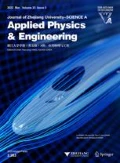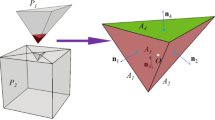Abstract
A graphics processing unit (GPU)-accelerated vector-form particle-element method, i.e., the finite particle method (FPM), is proposed for 3D elastoplastic contact of structures involving strong nonlinearities and computationally expensive contact calculations. A hexahedral FPM element with reduced integration and anti-hourglass is developed to model structural elastoplastic behaviors. The 3D space containing contact surfaces is decomposed into cubic cells and the contact search is performed between adjacent cells to improve search efficiency. A connected list data structure is used for storing contact particles to facilitate the parallel contact search procedure. The contact constraints are enforced by explicitly applying normal and tangential contact forces to the contact particles. The proposed method is fully accelerated by GPU-based parallel computing. After verification, the performance of the proposed method is compared with the serial finite element code Abaqus/Explicit by testing two large-scale contact examples. The maximum speedup of the proposed method over Abaqus/Explicit is approximately 80 for the overall computation and 340 for contact calculations. Therefore, the proposed method is shown to be effective and efficient.
摘要
目的
结构的三维弹塑性接触问题通常包含强非线性, 且计算比较耗时。为解决这类问题, 本文提出基于图形处理器加速的有限质点法。
创新点
1. 发展基于有限质点法的六面体缩减积分单元; 2. 提出结构的三维并行接触算法。
方法
1. 发展基于有限质点法的六面体缩减积分单元, 并采用沙漏控制技术, 用于模拟结构的弹塑性行为; 2. 提出结构的三维并行接触算法, 将包含接触面的三维空间分解为立方体单元格, 仅在相邻单元格之间进行接触搜索, 并使用链式数据结构存储接触质点; 3. 通过基于图形处理器的并行计算技术对算法进行加速。
结论
1. 本文方法与有限元软件Abaqus/Explicit相比, 在总计算时间和接触计算时间上分别提升效率约80倍和340倍; 2. 本文方法的有效性和计算效率都得到了验证。
Similar content being viewed by others
References
Bartezzaghi A, Cremonesi M, Parolini N, et al., 2015. An explicit dynamics GPU structural solver for thin shell finite elements. Computers & Structures, 154:29–40. https://doi.org/10.1016/j.compstruc.2015.03.005
Benson DJ, Hallquist JO, 1990. A single surface contact algorithm for the post-buckling analysis of shell structures. Computer Methods in Applied Mechanics and Engineering, 78(2):141–163. https://doi.org/10.1016/0045-7825(90)90098-7
Biabanaki SOR, Khoei AR, Wriggers P, 2014. Polygonal finite element methods for contact-impact problems on non-conformal meshes. Computer Methods in Applied Mechanics and Engineering, 269:198–221. https://doi.org/10.1016/j.cma.2013.10.025
Borja RI, 2013. Plasticity: Modeling & Computation. Springer, Berlin, Germany. https://doi.org/10.1007/978-3-642-38547-6
Cai Y, Wang GP, Li GY, et al., 2015. A high performance crashworthiness simulation system based on GPU. Advances in Engineering Software, 86:29–38. https://doi.org/10.1016/j.advengsoft.2015.04.003
Cao XG, Cai Y, Cui XY, 2020. A parallel numerical acoustic simulation on a GPU using an edge-based smoothed finite element method. Advances in Engineering Software, 148:102835. https://doi.org/10.1016/j.advengsoft.2020.102835
Chen H, Lei Z, Zang MY, 2014. LC-Grid: a linear global contact search algorithm for finite element analysis. Computational Mechanics, 54(5):1285–1301. https://doi.org/10.1007/s00466-014-1058-5
Cheng J, Grossman M, McKercher T, 2014. Professional CUDA C Programming. John Wiley & Sons, Indianapolis, USA.
Dong YK, Wang D, Randolph MF, 2015. A GPU parallel computing strategy for the material point method. Computers and Geotechnics, 66:31–38. https://doi.org/10.1016/j.compgeo.2015.01.009
Flanagan DP, Belytschko T, 1981. A uniform strain hexahedron and quadrilateral with orthogonal hourglass control. International Journal for Numerical Methods in Engineering, 17(5):679–706. https://doi.org/10.1002/nme.1620170504
Gao B, Wu J, Jia PC, et al., 2022. Experimental and numerical investigation of the polyurea-coated ultra-high-performance concrete (UHPC) column under lateral impact loading. International Journal of Structural Stability and Dynamics, 22(5):2250037. https://doi.org/10.1142/S0219455422500377
Hallquist JO, Goudreau GL, Benson DJ, 1985. Sliding interfaces with contact-impact in large-scale Lagrangian computations. Computer Methods in Applied Mechanics and Engineering, 51(1–3):107–137. https://doi.org/10.1016/0045-7825(85)90030-1
Hesch C, Betsch P, 2011. Transient 3D contact problems-NTS method: mixed methods and conserving integration. Computational Mechanics, 48(4):437–449. https://doi.org/10.1007/s00466-011-0597-2
Hou JM, Shi BS, Liang QH, et al., 2021. A graphics processing unit-based robust numerical model for solute transport driven by torrential flow condition. Journal of Zhejiang University-SCIENCE A (Applied Physics & Engineering), 22(10):835–850. https://doi.org/10.1631/jzus.A2000585
Kang H, Kim J, 2015. Progressive collapse of steel moment frames subjected to vehicle impact. Journal of Performance of Constructed Facilities, 29(6):04014172. https://doi.org/10.1061/(ASCE)CF.1943-5509.0000665
Lacasta A, Morales-Hernández M, Murillo J, et al., 2014. An optimized GPU implementation of a 2D free surface simulation model on unstructured meshes. Advances in Engineering Software, 78:1–15. https://doi.org/10.1016/j.advengsoft.2014.08.007
Luo YZ, Yang C, 2014. A vector-form hybrid particle-element method for modeling and nonlinear shell analysis of thin membranes exhibiting wrinkling. Journal of Zhejiang University-SCIENCE A (Applied Physics & Engineering), 15(5):331–350. https://doi.org/10.1631/jzus.A1300248
Neto DM, Oliveira MC, Menezes LF, 2017. Surface smoothing procedures in computational contact mechanics. Archives of Computational Methods in Engineering, 24(1):37–87. https://doi.org/10.1007/s11831-015-9159-7
Seitz A, Popp A, Wall WA, 2015. A semi-smooth newton method for orthotropic plasticity and frictional contact at finite strains. Computer Methods in Applied Mechanics and Engineering, 285:228–254. https://doi.org/10.1016/j.cma.2014.11.003
Sharma A, Mishra R, Jain S, et al., 2018. Deformation behavior of single and multi-layered materials under impact loading. Thin-Walled Structures, 126:193–204. https://doi.org/10.1016/j.tws.2017.08.021
Simo JC, Hughes TJR, 1998. Computational Inelasticity. Springer, New York, USA.
Tang JZ, Zheng YF, Yang C, et al., 2020. Parallelized implementation of the finite particle method for explicit dynamics in GPU. Computer Modeling in Engineering & Sciences, 122(1):5–31. https://doi.org/10.32604/cmes.2020.08104
Wang SQ, Zhang Q, Ji SY, 2021. GPU-based parallel algorithm for super-quadric discrete element method and its applications for non-spherical granular flows. Advances in Engineering Software, 151:102931. https://doi.org/10.1016/j.advengsoft.2020.102931
Wang W, Zheng YF, Tang JZ, et al., 2021. A GPU-based parallel algorithm for 2D large deformation contact problems using the finite particle method. Computer Modeling in Engineering & Sciences, 129(2):595–626. https://doi.org/10.32604/cmes.2021.017321
Wriggers P, 2006. Computational Contact Mechanics. Springer, Berlin, Germany. https://doi.org/10.1007/978-3-540-32609-0
Yang C, Shen YB, Luo YZ, 2014. An efficient numerical shape analysis for light weight membrane structures. Journal of Zhejiang University-SCIENCE A (Applied Physics & Engineering), 15(4):255–271. https://doi.org/10.1631/jzus.A1300245
Yu Y, Luo YZ, 2009. Finite particle method for kinematically indeterminate bar assemblies. Journal of Zhejiang University-SCIENCE A, 10(5):669–676. https://doi.org/10.1631/jzus.A0820494
Zang MY, Gao W, Lei Z, 2011. A contact algorithm for 3D discrete and finite element contact problems based on penalty function method. Computational Mechanics, 48(5):541–550. https://doi.org/10.1007/s00466-011-0606-5
Zheng YF, Wan HP, Zhang JY, et al., 2021. Local-coordinate representation for spatial revolute clearance joints based on a vector-form particle-element method. International Journal of Structural Stability and Dynamics, 21(7):2150093. https://doi.org/10.1142/S0219455421500930
Acknowledgments
This work is supported by the National Natural Science Foundation of China (Nos. 51908492, 52008366, and 52238001) and the Zhejiang Provincial Natural Science Foundation of China (Nos. LY21E080022 and LQ21E080019).
Author information
Authors and Affiliations
Contributions
Wei WANG conducted the research and wrote the manuscript. Yanfeng ZHENG and Chao YANG helped design the research. Yanfeng ZHENG and Jingzhe TANG revised the manuscript. Yaozhi LUO provided funding and supervision.
Corresponding author
Ethics declarations
Wei WANG, Yanfeng ZHENG, Jingzhe TANG, Chao YANG, and Yaozhi LUO declare that they have no conflict of interest.
Additional information
Electronic supplementary materials
Sections S1–S8, Algorithm S1, Figs. S1–S9, Tables S1–S4, Eqs. (S1)–(S5)
Electronic Supplementary Materials
Rights and permissions
About this article
Cite this article
Wang, W., Zheng, Y., Tang, J. et al. GPU-accelerated vector-form particle-element method for 3D elastoplastic contact of structures. J. Zhejiang Univ. Sci. A 24, 1120–1130 (2023). https://doi.org/10.1631/jzus.A2200311
Received:
Accepted:
Published:
Issue Date:
DOI: https://doi.org/10.1631/jzus.A2200311
Key words
- Graphics processing unit (GPU)
- Parallel acceleration
- Elastoplastic contact
- Contact search
- Finite particle method (FPM)




